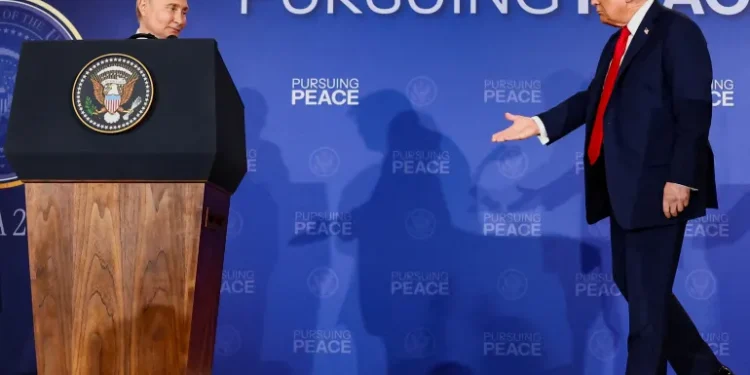President Donald Trump touched down in Anchorage, Alaska, on Friday, August 15th, for what could become a pivotal moment in modern geopolitics. With the world watching, he sat down with Russian President Vladimir Putin in an effort to broker peace between Moscow and Kyiv — a war that has drained lives, strained economies, and tested Western resolve for years.
Speaking candidly to reporters aboard Air Force One on the way to Alaska, Trump made his intentions clear. “I’m not here to negotiate for Ukraine. I’m here to get them at a table,” he said. Then, in words that captured both his bluntness and his caution, he added: “I’d like to focus on our country, but I’m doing this to save a lot of lives.”
That framing tells the story. For Trump, the mission isn’t about entangling America in another foreign conflict, but about leveraging U.S. strength to stop a war that has spiraled for too long. Conservatives will hear a familiar echo: an insistence that America’s role in the world should not mean endless commitments, blank checks, or open-ended deployments. Instead, it means using leverage, economic power, and leadership to serve peace while protecting U.S. interests.
The backdrop is important. For more than two years, Washington has poured tens of billions into Ukraine with little accountability, while Europe has often dragged its feet on defense spending. Americans are right to ask whether this is a common-sense strategy or another case of bureaucratic overreach at the expense of taxpayers. Trump’s Alaska summit suggests a different approach: diplomacy first, financial prudence second, and strength as a deterrent rather than a permanent foreign garrison.
Anchorage may seem like an unusual place for such a high-stakes meeting, but symbolically it underscores the point. Alaska is American soil on the Pacific frontier — a reminder that U.S. security is not measured by faraway nation-building, but by protecting our homeland and preventing conflicts from spiraling into global burdens.
The stakes could not be higher. Russia’s invasion of Ukraine upended post–Cold War stability in Europe, sparked a humanitarian crisis, and opened debates about energy, sovereignty, and the future of NATO. Every administration since the Cold War has claimed to want peace in Eastern Europe, but too often the pattern has been endless aid packages, sprawling military missions, and little measurable progress. Trump’s push flips that script. He is betting that bringing Putin to the table is the only way to stop the cycle.
Of course, the risks are real. If Putin uses the summit as a stage for delay or deception, America will have spent precious political capital for nothing. Trump himself acknowledged as much, warning that consequences would follow if Russia engaged in bad faith. That blunt warning reflects a longstanding conservative principle: peace is best pursued from a position of strength, not weakness.
The long war in Ukraine has left much of the Western public weary. Americans have grown skeptical of global elites promising “stability” while asking families at home to foot the bill. Trump’s language about wanting to “focus on our country” taps into that weariness while also recognizing that true leadership sometimes requires stepping up to prevent greater costs down the line. His challenge in Anchorage was to strike that balance — showing the world America can lead without endlessly bleeding its people and resources abroad.
The outcome of this summit may not be known immediately. Yet the effort itself matters. It signals that the United States, under Trump’s leadership, will not be strong-armed into more blank checks or open-ended wars, but will instead push for direct solutions rooted in realism and strength. For conservatives, that looks a lot like common sense: a leader who knows that lasting peace begins with honest talks, firm leverage, and a clear priority on America first.




















